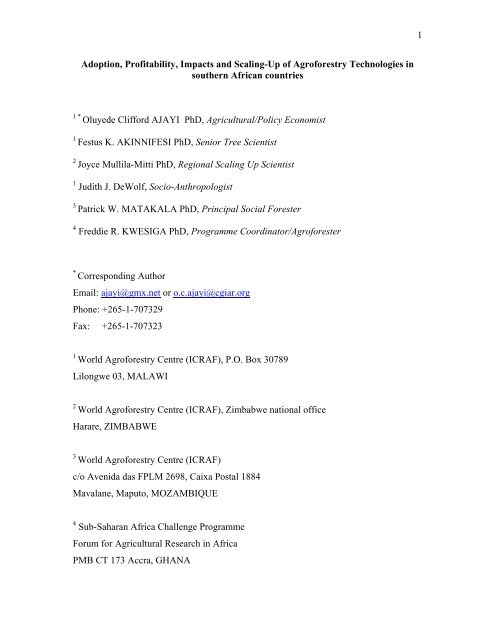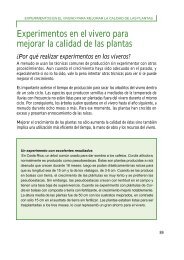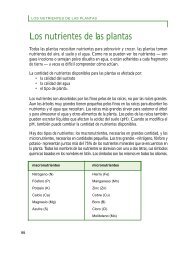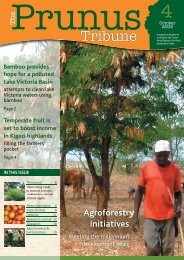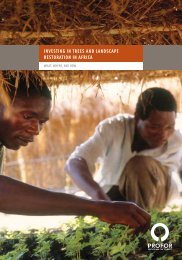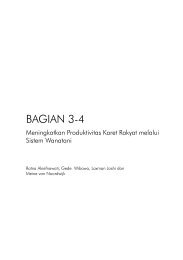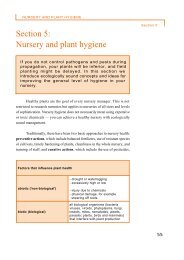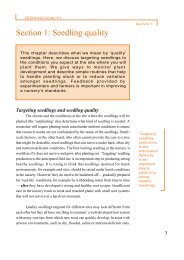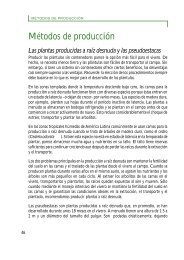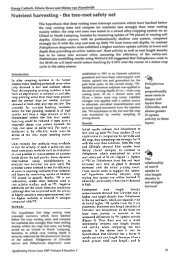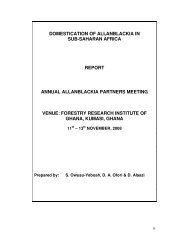1 Adoption, Profitability, Impacts and Scaling-Up of Agroforestry ...
1 Adoption, Profitability, Impacts and Scaling-Up of Agroforestry ...
1 Adoption, Profitability, Impacts and Scaling-Up of Agroforestry ...
Create successful ePaper yourself
Turn your PDF publications into a flip-book with our unique Google optimized e-Paper software.
1<strong>Adoption</strong>, <strong>Pr<strong>of</strong>itability</strong>, <strong>Impacts</strong> <strong>and</strong> <strong>Scaling</strong>-<strong>Up</strong> <strong>of</strong> Agr<strong>of</strong>orestry Technologies insouthern African countries1 *Oluyede Clifford AJAYI PhD, Agricultural/Policy Economist1Festus K. AKINNIFESI PhD, Senior Tree Scientist2Joyce Mullila-Mitti PhD, Regional <strong>Scaling</strong> <strong>Up</strong> Scientist1 Judith J. DeWolf, Socio-Anthropologist3Patrick W. MATAKALA PhD, Principal Social Forester4 Freddie R. KWESIGA PhD, Programme Coordinator/Agr<strong>of</strong>orester*Corresponding AuthorEmail: ajayi@gmx.net or o.c.ajayi@cgiar.orgPhone: +265-1-707329Fax: +265-1-7073231World Agr<strong>of</strong>orestry Centre (ICRAF), P.O. Box 30789Lilongwe 03, MALAWI2World Agr<strong>of</strong>orestry Centre (ICRAF), Zimbabwe national <strong>of</strong>ficeHarare, ZIMBABWE3World Agr<strong>of</strong>orestry Centre (ICRAF)c/o Avenida das FPLM 2698, Caixa Postal 1884Mavalane, Maputo, MOZAMBIQUE4 Sub-Saharan Africa Challenge ProgrammeForum for Agricultural Research in AfricaPMB CT 173 Accra, GHANA
2Table <strong>of</strong> contents1.0 Introduction............................................................................................................. 32.0 Agr<strong>of</strong>orestry technology options in southern African ............................................ 42.1 “Fertilizer tree systems”..................................................................................... 52.2 Biomass transfer.................................................................................................. 62.3 Indigenous fruit tree crop system........................................................................ 72.4 Rotational woodlots ............................................................................................ 82.5 Fodder banks:...................................................................................................... 93.0 <strong>Adoption</strong> <strong>of</strong> agr<strong>of</strong>orestry technologies ................................................................... 93.1 From technical feasibility to farmer adoption..................................................... 93.2 Factors affecting the adoption <strong>of</strong> agr<strong>of</strong>orestry.................................................. 103.3 Socio-anthropological perspective for underst<strong>and</strong>ing farmers’ adoption <strong>of</strong>agr<strong>of</strong>orestry................................................................................................................... 124.0 Financial pr<strong>of</strong>itability <strong>and</strong> returns to investment in agr<strong>of</strong>orestry technologies .... 135.0 <strong>Scaling</strong>-up <strong>of</strong> agr<strong>of</strong>orestry technologies ............................................................... 165.1 Approaches <strong>and</strong> methods for scaling-up........................................................... 165.2 Number <strong>of</strong> farmers reached through agr<strong>of</strong>orestry technologies ....................... 195.3 Constraints to the scaling up <strong>of</strong> agr<strong>of</strong>orestry .................................................... 206.0 Impact <strong>of</strong> agr<strong>of</strong>orestry technologies ..................................................................... 226.1 <strong>Impacts</strong> on yield <strong>and</strong> food security ................................................................... 236.2 Impact on the environment ............................................................................... 246.3 Impact on income generation <strong>and</strong> diversification <strong>of</strong> livelihood ....................... 256.4 Other impacts.................................................................................................... 277.0 Discussion <strong>and</strong> way forward................................................................................. 28References......................................................................................................................... 31Acknowledgement: The authors are grateful for the support provided by the CanadianInternational Development Agency (CIDA), Rockefeller Foundation, SwedishInternational Development Cooperation Agency (SIDA), the Netherl<strong>and</strong>s <strong>and</strong> nationalgovernments in the sub-region to the research <strong>and</strong> development <strong>of</strong> agr<strong>of</strong>orestry insouthern Africa.
31.0 IntroductionDue to a mix <strong>of</strong> agro-ecological factors (incessant drought, low soil fertility,environmental degradation) <strong>and</strong> other man-made problems (illiteracy, unfavorabledevelopment policies), southern Africa region faces several challenges includingworsening poverty, food insecurity, low income base <strong>and</strong> more recently HIV/AIDSp<strong>and</strong>emic. Low soil fertility is identified as one <strong>of</strong> the greatest biophysical constraints toincreasing agricultural productivity (Bekunda et al., 1997, Sanchez, 1999). Thedegradation <strong>of</strong> soils is caused by a breakdown <strong>of</strong> the traditional production systemsresulting from shortening <strong>of</strong> fallow periods due to population pressure (Kwesiga et al.,1999). With the collapse <strong>of</strong> the erstwhile government support for the use <strong>of</strong> mineralfertilizer (e.g. through subsidies <strong>and</strong> distribution channels), in the 1990s, the ability <strong>of</strong>most smallholder farmers to purchase the same level <strong>of</strong> mineral fertilizers was reducedbecause the input became unaffordable to them. In addition, many countries in southernAfrica are l<strong>and</strong>locked thus increasing the cost <strong>of</strong> transporting fertilizer from the ports.Howard <strong>and</strong> Mungoma (1996) estimated that the use <strong>of</strong> mineral fertilizer fell by 70%following an increase in the cost <strong>of</strong> the inputs. The sub-region also faces a rapiddegradation <strong>of</strong> the miombo woodl<strong>and</strong>, shortage <strong>of</strong> fodder <strong>and</strong> decreasing access t<strong>of</strong>uelwood supplies (Kwesiga <strong>and</strong> Beniest, 1998). For example, Chidumayo (1997)estimated that Zambia alone loses about 200 000 ha <strong>of</strong> forests per year. Some <strong>of</strong> the keyavenues for overcoming food insecurity <strong>and</strong> rural poverty in southern Africa includereversing soil fertility depletion, intensifying <strong>and</strong> diversifying l<strong>and</strong> use with introduction<strong>of</strong> high value products, <strong>and</strong> facilitating an appropriate policy environment for the smallholderfarming sector. While mineral fertilizer is still one <strong>of</strong> the best options for
4overcoming l<strong>and</strong> depletion <strong>and</strong> increasing food production, the majority <strong>of</strong> thesmallholder farmers are unable to afford <strong>and</strong> apply the fertilizers at the recommendedrates <strong>and</strong> at the appropriate time because <strong>of</strong> high cost <strong>and</strong> delivery delays (Kwesiga et al,2003; Akinnifesi et al, 2006). Low-cost technologies are needed on a scale wide enoughto improve the livelihood <strong>of</strong> these farmers. This will require the adoption <strong>of</strong> newapproaches to agriculture <strong>and</strong> rural development (Pretty, 1995). Agr<strong>of</strong>orestry has provento be one <strong>of</strong> such approaches. For the past fifteen years, farmers <strong>and</strong> researchers fromdifferent national <strong>and</strong> international institutions led by the International Centre forResearch in Agr<strong>of</strong>orestry (ICRAF), otherwise known as the World Agr<strong>of</strong>orestry Centrehave been combining their expertise <strong>and</strong> resources to develop agr<strong>of</strong>orestry technologies<strong>and</strong> options to address some <strong>of</strong> these challenges facing smallholder agriculturalproduction <strong>and</strong> the environment in the sub-region. The different types <strong>of</strong> agr<strong>of</strong>orestrytechnologies address specific human <strong>and</strong> environmental needs in southern Africa. Theseinclude fertilizer tree systems for replenishing soil fertility, rotational woodlots forsolving fuel wood problems, fodder banks to supplement feed for livestock <strong>and</strong>indigenous fruit trees for improving nutrition during the seasonal hunger periods <strong>and</strong>enhance the preservation <strong>of</strong> indigenous plant genetic materials.2.0 Agr<strong>of</strong>orestry technology options in southern AfricanThe key agr<strong>of</strong>orestry technologies that have been the focus <strong>of</strong> research <strong>and</strong> developmentefforts in southern Africa region in the past 15 years are listed below:
52.1 “Fertilizer tree systems”This system is one <strong>of</strong> the pioneer agr<strong>of</strong>orestry technologies in southern Africa region. Itsdevelopment began in Zambia <strong>and</strong> it includes improved tree fallows (common in Zambia)<strong>and</strong> mixed inter-cropping technologies (popular in Malawi). The concept <strong>of</strong> intensifyingl<strong>and</strong> use for sustainable crop production by integrating nitrogen fixing trees <strong>and</strong> crops forsoil fertility replenishment requires careful selection <strong>of</strong> agr<strong>of</strong>orestry technologies <strong>and</strong>judicious management <strong>of</strong> limited available resources. The expectations <strong>of</strong> households<strong>and</strong> their preferences were important considerations in designing technologies <strong>and</strong>choosing appropriate species. The mechanisms for improved soil fertility in fertilizer treesystems are explained by the capacity <strong>of</strong> certain leguminous trees to fix large amounts <strong>of</strong>nitrogen from the air through rhizobia contained in their root nodules, <strong>and</strong> accumulate thefixed N, together with the native soil nutrients they draw from different soil horizons intheir roots, stems branches <strong>and</strong> leaves as they grow, <strong>and</strong> the nutrients accumulated in treebiomass during growth. The tree biomass is then cut <strong>and</strong> the biomass is incorporated intothe soil during l<strong>and</strong> preparation. When the tree biomass decomposes, it releases nutrientsto crops grown in the subsequent two to three years without adding external fertilizer butrelying simply on the residual effect <strong>of</strong> the increased soil fertility. Fertilizer tree systemsdo not produce a similar instantaneous effect on crop yields as mineral fertilizers; treesneed time <strong>and</strong> resources on their own to get well established in the field. The plantspecies used in fertilizer tree systems to overcome soil fertility problems in southernAfrica include improved fallows based on Sesbania sesban, Tephrosia spp., Gliricidiasepium <strong>and</strong> Cajanus cajan <strong>and</strong> relay fallow cropping with short rotation shrub <strong>and</strong> treespecies. Results showed that two-year fallows with Sesbania can yield nitrogen biomass
6in the range <strong>of</strong> 70-100 kg/ha is generally accumulated <strong>and</strong> can be applied as greenmanure, resulting. Field trials show that maize yields obtained from such fertilizer treesystems consistently reaches two or more times the yields from farmers’ practice <strong>of</strong>continuous maize production without application <strong>of</strong> external mineral fertilizer inputs.Further details <strong>of</strong> fertilizer tree systems are described elsewhere (Mafongoya et al., 2003;Phiri et al ., 2003)2.2 Biomass transferFarmers have been growing vegetables widely during the dry season in wetl<strong>and</strong>s (knownlocally as dambos) but declining soil fertility has posed a major challenge. Biomasstransfer refers to cutting <strong>and</strong> carrying (“transferring”) nutrient-rich leaves <strong>of</strong> agr<strong>of</strong>orestryspecies (usually planted in the upl<strong>and</strong>) to fertilize fields for the production <strong>of</strong> high valuevegetable crops <strong>and</strong> an extra maize crop in the dambos during the dry season. Biomasstransfer <strong>of</strong>fers smallholder farmers the opportunity to supplement their incomes bygrowing cash crops that fetch high prices in urban markets. In this system, nitrogenfixing trees or shrubs are planted on a separate plot <strong>and</strong> the leaves are regularly cut <strong>and</strong>used to fertilize neighbouring field plots in a cut-<strong>and</strong>-carry way, especially in the dambos.It simply involves transferring <strong>of</strong> leaves <strong>and</strong> twigs <strong>of</strong> fertilizer trees from one part <strong>of</strong> thefarm to another. Farmers harvest trees planted at the upl<strong>and</strong> to fertilize vegetablescultivated in the dambos during the dry-season <strong>and</strong> use the coppices to fertilize theirmaize during the main season, thereby having two full crops in a year. In EasternZambia, Gliricidia sepium leaf mulches were used in combination with nitrogenfertilizers. In a given season, the responses to Gliricidia sepium leaf biomass wereconsistently higher than those <strong>of</strong> sole crop <strong>and</strong> mulch from other sources. It was
7estimated that yield <strong>of</strong> 3 t/ha <strong>of</strong> maize could be achieved either through application <strong>of</strong> 52kg/ha N or incorporation <strong>of</strong> 3.4 t/ha (dry weight) or 15 t/ha fresh weight <strong>of</strong> Gliricidiagreen manure.2.3 Indigenous fruit tree crop systemMany miombo indigenous fruit trees are important for food <strong>and</strong> nutritional security, aswell as being a source <strong>of</strong> income for rural communities in the Southern Africa, withwomen <strong>and</strong> children being the main beneficiaries (Akinnifesi et al, 2004; 2006). It hasbeen estimated that, wild fruit trees represent about 20% <strong>of</strong> total woodl<strong>and</strong> resource useby rural households in Zimbabwe (Campbell et al, 1997). Until recently there has beenlittle effort to cultivate, improve or add value to these fruits. In complementing theearlier emphasis on soil fertility improvement, developing indigenous fruit <strong>and</strong> nut treesinto tree crop system continue to be an important strategy to reduce poverty <strong>and</strong> hunger<strong>and</strong> to create employment opportunities in rural areas (Akinnifesi et al, 2004, 2006).Domestication involves accelerated <strong>and</strong> human-induced evolution to bring species intowider cultivation through a farmer-driven <strong>and</strong> market-led process (ICRAF, 1997). Thetree domestication initiative aims at building on the desire <strong>of</strong> rural communities tocultivate indigenous fruits <strong>and</strong> nuts meet their livelihood needs, especially food <strong>and</strong>nutritional security, increase household income, create employment <strong>and</strong> diversify farmingsystems <strong>and</strong> the rural economy (Akinnifesi et al, 2006). The domesticating <strong>of</strong> indigenousfruit trees will increase their quality <strong>and</strong> productivity, <strong>and</strong> can also create opportunitiesfor marketing their products, so empowering smallholder farming communities toconserve <strong>and</strong> cultivate them. Tree crop development <strong>and</strong> commercialization <strong>of</strong>indigenous fruit trees from the miombo woodl<strong>and</strong>s in southern Africa requires a long-
8term, iterative <strong>and</strong> integrated strategy for tree selection <strong>and</strong> improvement, for thepromotion, use <strong>and</strong> marketing <strong>of</strong> selected germplasm <strong>and</strong> its integration into agr<strong>of</strong>orestrypractices (Akinnifesi et al, 2006). Based on household surveys to identify the importanttraits for improvement, the four priority indigenous fruit tree species that were identifiedin southern Africa are Uapaca kirkiana, Strychnos cocculoides, Parinari curatellifolia<strong>and</strong> Sclerocarya birrea. More recently, the marketing <strong>and</strong> commercialization component<strong>of</strong> this programme is receiving more emphasis. Rural entrepreneurs have been trained infruit processing <strong>and</strong> business skills. The dissemination <strong>of</strong> these innovations haveinvolved farmer-to-farmer exchanges where successful farmers pass on their skills <strong>and</strong>experience to new farmers entering the business, as well as formal courses to traintrainers. This bottom-up approach has ensured community ownership <strong>of</strong> theimplementation <strong>of</strong> the business <strong>and</strong> dissemination skills, <strong>and</strong> a market driven treedomestication initiative <strong>and</strong> promises to have a significant effect in raising rural incomes.2.4 Rotational woodlotsThe problem <strong>of</strong> deforestation is high in southern Africa region, particularly in intensetobacco-growing countries such as Tanzania <strong>and</strong> Mozambique where farmers requirehigh quantities <strong>of</strong> fuelwood to cure the leaves. Rotational woodlots are meant primarily toprovide high quality wood biomass. Some <strong>of</strong> the woodlot species also helps to fertilizethe soil <strong>and</strong> are therefore grown in rotation with food crops (Kwesiga et al 2003). Themain woodlot species that have been promoted in the sub-region are Acacias especiallyAcacia crassicarpa <strong>and</strong> Acacia polyacantha <strong>and</strong> Acacia auriculiformis
92.5 Fodder banks:This involves the growing, harvesting <strong>and</strong> preservation <strong>of</strong> browse <strong>of</strong> nutritious proteinrichleguminous trees leaves during the wet season <strong>and</strong> using them as protein supplementfor ruminant animals during the dry season. Although commercial feed concentrate isavailable, smallholder farmers consider it expensive <strong>and</strong> many can not afford it. Theresearch <strong>and</strong> development <strong>of</strong> this agr<strong>of</strong>orestry technology has been much moreemphasized in Zimbabwe where livestock production is more predominant. Thisagr<strong>of</strong>orestry technology helps to reduce the cost <strong>of</strong> formulated animal concentrate feedsfor smallholder farmers.3.0 <strong>Adoption</strong> <strong>of</strong> agr<strong>of</strong>orestry technologies3.1 From technical feasibility to farmer adoptionIn the past one <strong>and</strong> half decades, the biophysical performance <strong>and</strong> the relevance <strong>of</strong> theagr<strong>of</strong>orestry technologies in southern Africa have been well demonstrated (Kwesiga <strong>and</strong>Coe, 1994; Mafongoya et al., 2003; Kwesiga et al., 2003; Nyadzi et al., 2003;, Mithoefer<strong>and</strong> Waibel, 2003; Kuntashula et al., 2004). As this chapter shows, gradually the focus <strong>of</strong>agr<strong>of</strong>orestry research has changed from purely biophysical <strong>and</strong> field trials to theincorporation <strong>of</strong> socio-economic <strong>and</strong> on-farm research to allow for studies <strong>of</strong> pr<strong>of</strong>itability<strong>and</strong> acceptability <strong>of</strong> the different agr<strong>of</strong>orestry technologies to be carried out in a muchmore real-life context. Research <strong>and</strong> development activities on agr<strong>of</strong>orestry havetherefore exp<strong>and</strong>ed to include questions on farmer uptake, adoption <strong>and</strong> impact <strong>of</strong> thetechnologies. Farmer adoption <strong>and</strong> the impact <strong>of</strong> new farm technologies on adopters (<strong>and</strong>
10non adopters) are some <strong>of</strong> the key measures <strong>of</strong> the overall success or otherwise <strong>of</strong> suchinnovations.In general, the uptake <strong>of</strong> agr<strong>of</strong>orestry technologies is more complicated than those <strong>of</strong>annual crops (Mercer, 2004; Scherr <strong>and</strong> Müller, 1991) because <strong>of</strong> the multi-components<strong>and</strong> the multi-years through which testing, modification <strong>and</strong> uptake <strong>of</strong> the technologiestakes place. As a result, a precise definition <strong>of</strong> the “adoption” <strong>of</strong> agr<strong>of</strong>orestry <strong>of</strong>ten posesa challenge. Some authors (e.g. Adesina et al., 2000; Franzel et al., 2002) distinguishedbetween “testers”, “experimenters” <strong>and</strong> “adopters”. Other authors (e.g. Ajayi et al., 2003)regard the uptake <strong>of</strong> agr<strong>of</strong>orestry technologies as a continuum <strong>and</strong> posit that farmers canbe assigned positions in the continuum based on the extent <strong>of</strong> uptake <strong>of</strong> the differentcomponents <strong>of</strong> the technology. A recent study in Zambia (Ajayi, 2006) reveals that thekey criteria that farmers use for assessing the level <strong>of</strong> “adoption” <strong>of</strong> agr<strong>of</strong>orestrytechnologies are as follows: good management (timely weeding & pruning) <strong>of</strong>agr<strong>of</strong>orestry fields, density <strong>and</strong> mix <strong>of</strong> trees species planted, number <strong>of</strong> years <strong>of</strong>continuous practice <strong>of</strong> agr<strong>of</strong>orestry <strong>and</strong>, size <strong>of</strong> l<strong>and</strong> area that a farmer cultivates toagr<strong>of</strong>orestry. In a strict sense therefore, different degrees <strong>of</strong> “adoption” <strong>of</strong> agr<strong>of</strong>orestrytechnologies can be identified.3.2 Factors affecting the adoption <strong>of</strong> agr<strong>of</strong>orestrySeveral empirical studies have been carried out to gain insights into the adoption <strong>of</strong>agr<strong>of</strong>orestry in southern Africa region. The specific studies investigated the types <strong>of</strong>farmers who adopt (do not adopt) agr<strong>of</strong>orestry (Kuntashula et al., 2002; Phiri et al, 2004;Gladwin et al., 2002; Ajayi et al 2006b). Other studies examined the factors that drive the
11adoption <strong>of</strong> agr<strong>of</strong>orestry; why do some farmers continue to adopt more than others (Ajayiet al, 2003; Place et al., 2002; Franzel <strong>and</strong> Scherr, 2002; Ajayi <strong>and</strong> Kwesiga, 2003; Keilet al., 2005; Ajayi, 2006; Jera et al., 2006; Thangata <strong>and</strong> Alavalapati, 2003).Table 1: Factors affecting farmers’ decision to adopt fertilizer tree systems inZambia.Study(<strong>and</strong> number <strong>of</strong>households involved)WealthAgeSexEducationLabor/HouseholdsizeFarmsizeUncultivated l<strong>and</strong>Use<strong>of</strong>fertilizerOfffarmincomeOxenownershipVillageexposuretoimprovedfallowsFactors affecting farmers’ decision to plant fertilizer tree fallows for the first timeFranzel, S. 1999(157 households)NNPhiri et al. (2004)(218 households)Kuntashula et al. 2002(218 households)Ajayi et al. 2006 (305households )Peterson et al. 1999(320 households)+ N ++ N N + N N +N +,N N ++ + +Factors affecting farmers’ decision to continue to plant fertilizer treesKeil 2001(100 households)+/- N N N + +Place et al. 2002 + N N N N +Legend: +: positive association with planting improved fallows-: negative associationN: no association, +/-: positive or negative depending on the valueBlank means the variable was not tested in the specific study.Access to about information on agr<strong>of</strong>orestry, training opportunities, good quality seeds,property rights on l<strong>and</strong>, size <strong>of</strong> available l<strong>and</strong>, flexibility <strong>and</strong> compatibility <strong>of</strong>agr<strong>of</strong>orestry to existing farming systems among others are important factors affectingadoption <strong>of</strong> agr<strong>of</strong>orestry (Place <strong>and</strong> Dewees, 1999, Place, 1995). The result <strong>of</strong> specific
12empirical studies to assess the factors influencing the adoption <strong>of</strong> agr<strong>of</strong>orestry (fertilitytree systems) in Zambia is summarized in table 1. In general, the factors which influencedfarmers’ adoption decision with regards to agr<strong>of</strong>orestry technologies fall within fourbroad categories. These are those which exert (1) positive influence on farmers’ adoptiondecisions, (2) negative impacts (3) ambiguous or no direct effect (4) systemic influenceon all types <strong>of</strong> households in a given community <strong>and</strong> spatial locations.3.3 Socio-anthropological perspective for underst<strong>and</strong>ing farmers’adoption <strong>of</strong> agr<strong>of</strong>orestryA number <strong>of</strong> surveys to investigate the actual <strong>and</strong> potential adoption <strong>of</strong> agr<strong>of</strong>orestrytechnologies have focused primarily on the influence <strong>of</strong> different household <strong>and</strong> farmcharacteristics on the adoption by farmers. However, the inevitable implication thatmeasuring the influence <strong>of</strong> household <strong>and</strong> farm characteristics in itself may provideinsufficient explanations <strong>and</strong> thus there is need for different approaches. The process <strong>of</strong>adoption is complicated, dynamic <strong>and</strong> the various factors are likely to influence eachother – hence they should not be treated in isolation, ignoring their mutualinterdependencies <strong>and</strong> reducing the adoption-decision to a zero-sum game, as isfrequently done. If individual household <strong>and</strong> farm characteristics are singled out, whereone study considers a certain characteristic to have a positive influence on adoption,another study may view the same characteristic as having a negative influence. Thedifferences can sometimes very well be clarified from the institutional <strong>and</strong> social contexts<strong>of</strong> the specific respective study areas. Such qualitative research methodologiescompliment quantitative research approaches, provide insights into farmers’ adoptionpatterns <strong>and</strong> improve the underst<strong>and</strong>ing <strong>of</strong> the process <strong>of</strong> adoption <strong>of</strong> agr<strong>of</strong>orestry
13technologies from the perspective <strong>of</strong> farmers. The qualitative methodologies may enablethe comprehension <strong>of</strong> the process <strong>of</strong> adoption on the basis <strong>of</strong> diversity as found amongstinformants <strong>and</strong> generating the relevant variables in the course <strong>of</strong> interviewing <strong>and</strong>observation (see e.g. van Donge et al., 2001). This qualitative approach was used to studythe history <strong>of</strong> interventions <strong>and</strong> the present-day consequences for agr<strong>of</strong>orestry adoption insouthern Malawi. Given the complex process <strong>of</strong> decision making by farmers, an adjustedresearch methodology is necessary to gain a better underst<strong>and</strong>ing <strong>of</strong> the process <strong>of</strong>adoption, which needs to be contextualized, both within the socio-economic context <strong>of</strong>the farm <strong>and</strong> family enterprise <strong>and</strong> in time.4.0 Financial pr<strong>of</strong>itability <strong>and</strong> returns to investment in agr<strong>of</strong>orestrytechnologies<strong>Pr<strong>of</strong>itability</strong> analyses that wee carried out in southern Africa region show that the variousagr<strong>of</strong>orestry technologies are pr<strong>of</strong>itable relative to conventional production practiceswhere trees are not grown (Franzel, 2004; Ajayi et al., 2006a; Place et al., 2002).The results <strong>of</strong> a recent study in Zambia to assess the financial pr<strong>of</strong>itability <strong>of</strong> five soilfertility management technologies- Sesbania sesban, Gliricidia sepium, Tephrosiavogelii, continuous maize production with fertilizer <strong>and</strong> continuous maize productionwithout fertilizer show that over a five-year period, agr<strong>of</strong>orestry-based soil fertilitymanagement technology (“fertilizer tree fallows”) are more pr<strong>of</strong>itable than farmers’practices <strong>of</strong> continuous maize production without external inputs but, it is less pr<strong>of</strong>itablethan full fertilizer application (Ajayi et al, 2006 a ). The 50% government subsidy onmineral fertilizer particularly enhanced its superior financial performance overagr<strong>of</strong>orestry-based options. However, when valued at its market price, the magnitude <strong>of</strong>
14the differences in the pr<strong>of</strong>itability <strong>of</strong> agr<strong>of</strong>orestry option <strong>and</strong> mineral fertilizer optiondecreases by 30%, <strong>and</strong> the net present value <strong>of</strong> fertilizer ($349) is very close to one <strong>of</strong> theagr<strong>of</strong>orestry options (NPV <strong>of</strong> $309). The mineral fertilizer option has a lower benefit costratio (BCR) implying that the higher net benefits obtained in mineral fertilizer option wasachieved through a relatively higher investment cost.Table 2: <strong>Pr<strong>of</strong>itability</strong> <strong>of</strong> maize production per hectare using tree fallows <strong>and</strong> subsidizedfertilizer options over a five-year cycle in ZambiaType <strong>of</strong>production systemDescription <strong>of</strong> l<strong>and</strong> usesystemNPV NPV BCR(ZambianKwacha)(US $) ($/$)Continuous, NOFertilizer Continuous maize for 5 years 584,755 130 2.01Continuous +Fertilizer(subsidized at 50%)Continuous +Fertilizer(at non-subsidizedmarket price)Gliricidia sepiumSesbania sesbanTephrosia vogelliContinuous maize for 5 years 2,243,341 499 2.65Continuous maize for 5 years 1,570,500 349 1.772 years <strong>of</strong> Gliricidia fallowfollowed by 3 years <strong>of</strong> crop2 years <strong>of</strong> Sesbania fallowfollowed by 3 years <strong>of</strong> crop2 years <strong>of</strong> Tephrosia fallowfollowed by 3 years <strong>of</strong> crop1,211,416 269 2.911,390,535 309 3.131,048,901 233 2.77• Market price for fertilizer include a 50% subsidy by the government• Figures are on one hectare basis, using prevailing costs & prices <strong>and</strong> an annual discountrate <strong>of</strong> 30%Table 2 shows that that for every unit <strong>of</strong> money invested into maize production, thefarmer gains an extra 1.65 units through mineral fertilizer option, an extra 1.91 units <strong>of</strong>money if Gliricidia fallow option is used, an extra 2.13 units <strong>of</strong> money in Sesbania
15sesban fallow fields, an extra 1.74 units <strong>of</strong> money in Tephrosia fallow fields <strong>and</strong> a 1.01unit <strong>of</strong> money if farmers’ conventional maize production practice is followed. Due to thechallenge <strong>of</strong> HIV/AIDS p<strong>and</strong>emic <strong>and</strong> its possible effect to degrade the quantity <strong>and</strong>quality <strong>of</strong> labor supply in farm households, it is hypothesized that the returns to labor willbecome an increasingly important factor in the acceptability <strong>of</strong> agricultural productiontechnologies to farmers <strong>and</strong> the decision to adopt them in the future. Analysis shows thatthe returns to a person labor-day is $3.20 for mineral fertilizer option <strong>and</strong> $2.50, $2.40,<strong>and</strong> $1.90 respectively for the three agr<strong>of</strong>orestry-based options that were investigated.By comparison, the return to labor for the unfertilized maize system was only $1.10,while the daily agricultural wage is around $0.50. Thus, while the recommended dose <strong>of</strong>fertilizer option is the highest performer at current subsidized rates, at the full economiccost, the tree fallow options are only slightly less economically attractive. In areas wheretransport costs <strong>of</strong> fertilizer are high, the tree fallow options may outperform the fertilizeroption. Sensitivity analysis shows that different price <strong>and</strong> other policy scenarios affect thefinancial pr<strong>of</strong>itability <strong>of</strong> different production systems. In general, the prevailing price <strong>of</strong>the staple crop (maize), cost <strong>of</strong> capital (interest rate), cost <strong>of</strong> including subsidy onfertilizer <strong>and</strong> the wage rate <strong>of</strong> labor are key determinants <strong>of</strong> the relative financialattractiveness <strong>and</strong> the potential adoptability <strong>of</strong> the production systems even whenagronomic relationships between inputs <strong>and</strong> outputs remain the same.Rotational woodlotsThe financial analysis carried out in Tanzania regarding rotational woodlots shows thatdespite higher costs <strong>and</strong> longer pay<strong>of</strong>f, rotational woodlots generate a net present value
16(NPV) <strong>of</strong> US$388 per hectare, which is six times higher than the net benefit obtained inconventional maize fallow systems (Franzel 2004). Rotational woodlots consistentlymaintained its superior financial performance over conventional maize systems evenwhen maize prices <strong>and</strong> labor cost changes up to 50%.5.0 <strong>Scaling</strong>-up <strong>of</strong> agr<strong>of</strong>orestry technologies5.1 Approaches <strong>and</strong> methods for scaling-upFollowing the successful demonstration <strong>of</strong> the potential <strong>of</strong> agr<strong>of</strong>orestry technologies tomake positive impact on the livelihoods <strong>of</strong> smallholder farmers in southern Africa,various agr<strong>of</strong>orestry research <strong>and</strong> development institutions have been focusing efforts inscaling up these technologies to reach a greater number <strong>of</strong> resource-poor smallholderfarmers who could potentially benefit from the technologies. <strong>Scaling</strong> up is expected tobring more quality benefits to more people over a wider geographic area, more quickly,more equitably <strong>and</strong> more lastingly. Due to the complexities <strong>of</strong> factors that affect scalingup, going to scale requires vertical <strong>and</strong> horizontal processes. The vertical processrepresents efforts to influence policy makers <strong>and</strong> donors <strong>and</strong> is generally institutional innature. The horizontal process (also referred to as scaling out) refers to the spread acrosscommunities <strong>and</strong> institutions <strong>and</strong> geographic boundaries (IIRR 2000). Both processescharacterize scaling up interventions <strong>of</strong> agr<strong>of</strong>orestry. Agr<strong>of</strong>orestry partners have focusedefforts on a process <strong>of</strong> institutionalizing agr<strong>of</strong>orestry in the research, extension, <strong>and</strong>development <strong>and</strong> education arenas in order to get policy makers, researchers, extensionworkers, development workers, educationalists <strong>and</strong> farmers to forge their efforts jointlyto address the factors that influence going to scale. At the policy level, each country has a
17National Agr<strong>of</strong>orestry Steering Committee (NASCO) charged with the responsibility t<strong>of</strong>acilitate the institutionalization <strong>of</strong> agr<strong>of</strong>orestry in the relevant sectors. Specifically, theNASCOs’ roles include identifying priority agr<strong>of</strong>orestry research <strong>and</strong> development areas<strong>and</strong> guiding donor support accordingly.Three major interrelated <strong>and</strong> mutually enforcing strategies employed in the scaling up <strong>of</strong>agr<strong>of</strong>orestry technologies in southern Africa are capacity building, partnerships <strong>and</strong>networking <strong>and</strong> promoting policies more conducive to adoption with the central focusbeing strengthening <strong>of</strong> local capacities to innovate as a way <strong>of</strong> ensuring sustainability <strong>of</strong>technological enhancement (Böhringer et al. 2003). Among the key interventionscharacterizing these strategies are the following: farmer-centred research <strong>and</strong> extensionapproaches, establishment <strong>of</strong> strategic partnerships, knowledge <strong>and</strong> information sharing,establishing viable seed systems, developing market options, local institutional capacitystrengthening, diversification <strong>of</strong> agr<strong>of</strong>orestry technologies <strong>and</strong> influencing policy atdifferent levels. In building farmer capacity <strong>and</strong> providing them with management <strong>and</strong>problem-solving skills through learning by experience in the field, a mixture <strong>of</strong>approaches are used to reach farmers <strong>and</strong> improve their lives through agr<strong>of</strong>orestry. Theseapproaches have been pursued within a framework <strong>of</strong> a scaling up concept initiallycomprising the following four prongs:Training <strong>of</strong> farmer trainers <strong>and</strong> local change teams: This approach involves directtraining <strong>of</strong> farmers as trainers with the ultimate goal being that the farmers trained will inturn provide training in agr<strong>of</strong>orestry to fellow farmers in a given locality.Training <strong>of</strong> project partners: This involves agr<strong>of</strong>orestry research institutions makingavailable training to the staff <strong>of</strong> development partners <strong>and</strong> NGO projects who works at
18the grassroots level. The major objective for this type <strong>of</strong> training is to enable partners toimplement training for farmer trainers in their own project areas.Farmer-to-farmer exchange visits: This approach involves exposing farmers toagr<strong>of</strong>orestry by facilitating their visits to farmers in other locations who have beenpracticing agr<strong>of</strong>orestry for some time <strong>and</strong> have started to get benefits from adoption <strong>of</strong>the technologies. As benefits accruing from agr<strong>of</strong>orestry technologies take long,especially the soil fertility improvement options, exposure <strong>of</strong> farmers to benefits realizedby those farmers who have adopted the technologies has proven to be a very effectiveway <strong>of</strong> promoting adoption.Support to national research <strong>and</strong> extension initiatives: This involves support to existinggovernment initiatives on sustainable farming, particularly extension work at the fieldlevel. One <strong>of</strong> the major challenges in implementing agr<strong>of</strong>orestry has beenunderinvestment in the public research <strong>and</strong> extension systems, manifested in severelogistical as well as methodological limitations.From 2004, other methodological approaches to scale up agr<strong>of</strong>orestry have beendeveloped. These include the use <strong>of</strong> exiting local institutions (<strong>and</strong> consultants) to conducttraining on agr<strong>of</strong>orestry, providing technical <strong>and</strong> logistics supports to agr<strong>of</strong>orestrynetworks, the establishment or strengthening <strong>of</strong> school community links <strong>and</strong> sensitizingpolicy-makers about agr<strong>of</strong>orestry benefits by producing policy briefs <strong>and</strong> use <strong>of</strong> publicmedia channels <strong>and</strong> events (local radio, TV programs, documentaries, field days,agricultural shows etc). These policy shapers include parliamentarians, cabinet ministers,provincial <strong>and</strong> district administrators, <strong>and</strong> village councilors, traditional authorities thatcould help catalyze adoption <strong>of</strong> agr<strong>of</strong>orestry /F in their respective constituencies.
195.2 Number <strong>of</strong> farmers reached through agr<strong>of</strong>orestry technologiesAs a result <strong>of</strong> these scaling up efforts, the number <strong>of</strong> farmers who have been reached withdifferent agr<strong>of</strong>orestry technologies in the five southern Africa countries has increasedfrom a few hundred farmers in the early 1990s to 417,000 farmers as at 2005 (ZBAFP,2005)Table 3: Numbers <strong>of</strong> farmers reached through different agr<strong>of</strong>orestry technologies in fivesouthern African countriesMethodological approach employed to reach farmersCountryTraining <strong>of</strong> Training <strong>of</strong> Support to national SchoolcommunitytotalsCountryfarmer trainers partner research <strong>and</strong>teams<strong>and</strong> local change institutionsinitiativesextensionlinkagesMalawi 15.476 68,243 26,982 - 110,701Mozambique 4,491 - - - 4,491Tanzania 15,000 106,228 83,000 29,500 233,728Zambia 15,387 37,838 8,358 - 61,583Zimbabwe - - - - 7,000*Prong totals 50,354 212,309 118,340 29,500 417,503Source: ZBAFP, 2005Note: The breakdown <strong>of</strong> the figure for Zimbabwe is not availableSeveral factors contribute to the increases recorded in the number <strong>of</strong> farmers who hasbeen reach through agr<strong>of</strong>orestry technologies. First, it is the deliberate effort by severalinstitutions to focus on the scaling up <strong>of</strong> the technologies using the different prongsdescribed above. Several institutions that were interested in promoting natural resourcemanagement options provided added impetus to disseminate information on agr<strong>of</strong>orestryinnovations among farmers. Such institutions include the World Vision IntegratedAgr<strong>of</strong>orestry Project in Zambia (ZIAP), Soil Conservation <strong>and</strong> Agr<strong>of</strong>orestry Extension
20(SCAFE) in Zambia, Malawi Agr<strong>of</strong>orestry <strong>and</strong> Extension (MAFE) <strong>and</strong> the EasternProvince Development Women Association (EPDWA). These were complemented byinterests in agr<strong>of</strong>orestry technology through organizations such as Plan Zambia <strong>and</strong>Kehitysyhteistyon Palvelukeskus (KEPA), a Finnish-based Service Centre forDevelopment Cooperation. In partnership with ICRAF, these institutions assisted inreaching a nucleus <strong>of</strong> farmers through direct training <strong>and</strong> provision <strong>of</strong> initial tree seed t<strong>of</strong>armers. The period coincided with the increasing emphasis by ICRAF on developmentprograms aimed at accelerating the scaling up/out agr<strong>of</strong>orestry technologies trees amongfarmers in the sub-region. Second, in the development <strong>of</strong> agr<strong>of</strong>orestry technologies insouthern Africa region, a constructivist approach was actively encouraged, i.e. farmerswere encouraged to try the technologies, then modify <strong>and</strong> re-adapt them based on theirexperiences <strong>and</strong> desires to make them more acceptable to their circumstances. Third,some private sector organizations found a niche in agr<strong>of</strong>orestry to fulfill their goal for aresponsible corporate citizenship by being responsive to the environmental <strong>and</strong> naturalresource implications <strong>of</strong> their activities. Among these are tobacco companies who aretraining their contract farmers on the use <strong>of</strong> poles from fertilizer tree species to makesheds for curing tobacco to avoid further deforestation associated with tobacco curingoperations.5.3 Constraints to the scaling up <strong>of</strong> agr<strong>of</strong>orestryA recent global review <strong>of</strong> the adoption <strong>of</strong> agr<strong>of</strong>orestry show that the level <strong>of</strong> diffusion <strong>of</strong>such agr<strong>of</strong>orestry technologies has generally lagged behind scientific <strong>and</strong> technologicaladvances attained in such technologies thereby, reducing their potential impacts (Mercer2004). The experience with regards to the adoption <strong>of</strong> agr<strong>of</strong>orestry technologies in
21southern Africa has not been too different from the global trend. Although agr<strong>of</strong>orestry isfinancially pr<strong>of</strong>itable <strong>and</strong> there has been an increasing trend in the uptake <strong>of</strong> thetechnologies by farmers, the widespread adoption <strong>of</strong> agr<strong>of</strong>orestry technologies by manymore smallholder farmers is nonetheless constrained by several challenges such as localcustoms, institutions <strong>and</strong> policies at the national level. Some <strong>of</strong> the constraints arehighlighted below:Local <strong>and</strong> national policies: some local customary practices <strong>and</strong> institutions prevailingin the sub-region (especially incidence <strong>of</strong> bush fires <strong>and</strong> browsing by livestock during thedry season, <strong>and</strong> absence <strong>of</strong> perennial private right over l<strong>and</strong>) limits the widespread uptake<strong>of</strong> some agr<strong>of</strong>orestry technologies. The animals destroy the trees after planting either bybrowsing the leaves <strong>and</strong> removing the biomass or by physically trampling over the plants.Community’s institutional regulations for fruit collection, l<strong>and</strong> <strong>and</strong> tree tenure all affectindividual farmer’s decision to invest in establishing an indigenous fruit tree orchard.However, agr<strong>of</strong>orestry institutions have been working in collaboration with traditionalrulers, government <strong>of</strong>ficials, community-based organizations, NGOs, <strong>and</strong> nationalpartners to resolve these institutional bottlenecks (Ajayi <strong>and</strong> Kwesiga, 2003).Training: Agr<strong>of</strong>orestry technologies are generally incipient technologies <strong>and</strong> relativelynew phenomenon compared with conventional agricultural practices that farmers haveknown, been used to <strong>and</strong> have received training for a much longer period. Unlike annualcrop production technologies <strong>and</strong> conventional soil fertility management options,fertilizer trees systems require skills in terms <strong>of</strong> management <strong>of</strong> the trees. Capacity fordoing this need be built at the national level. The costs <strong>of</strong> providing information greatly
22decrease over time, but they are critical when helping farmers get started with thepractice.Seed <strong>and</strong> germplasm: One <strong>of</strong> the greatest constraints <strong>of</strong> some agr<strong>of</strong>orestry technologiesis the lack <strong>of</strong> access to quality seeds. Unlike the seeds <strong>of</strong> annual crops in whichestablished institutions exist to promote them <strong>and</strong> private sector organizations have beenengaged in their multiplication <strong>and</strong> distribution, there is little or no institutional structureto make the seeds <strong>of</strong> agr<strong>of</strong>orestry available “<strong>of</strong>f the shelf”.Awareness: Over several years, there have been structural shifts towards “quick fixes”<strong>and</strong> technologies that render immediate benefits. The opportunity <strong>of</strong> agr<strong>of</strong>orestrytechnologies to provide some medium <strong>and</strong> long term benefits to individuals <strong>and</strong> thepublic simultaneously is not as yet well communicated to many stakeholders.Human resource capacity: The human capacity, infrastructures <strong>and</strong> institutional supportsfor agr<strong>of</strong>orestry are not as well developed as for annual crop technologies. Such missingsupports include well developed input <strong>and</strong> output market to enhance access <strong>of</strong> smallholderfarmers to ensure that they get the price premium for their crop produce.6.0 Impact <strong>of</strong> agr<strong>of</strong>orestry technologiesAgr<strong>of</strong>orestry technologies have multiple impacts on both adopters <strong>and</strong> non-adopters, onfood security <strong>and</strong> the environment as presented in Table X. The impacts <strong>of</strong> agr<strong>of</strong>orestrythat are most pronounced are on improved soil fertility (hence food security), moreincome <strong>and</strong> increased firewood supply. Some <strong>of</strong> the costs <strong>and</strong> benefits identified in Table4 occur simultaneously in the same agr<strong>of</strong>orestry field depending on the type <strong>of</strong> treeplanted. The Table is based on the several studies that were carried out in the regioncoupled with personal observations <strong>of</strong> the authors over several years <strong>of</strong> research <strong>and</strong>
23development work on agr<strong>of</strong>orestry in the region. Some <strong>of</strong> the costs <strong>and</strong> benefits require amore rigorous study to quantify their economic value. Despite the existence <strong>of</strong> negativespillovers <strong>of</strong> some aspects <strong>of</strong> agr<strong>of</strong>orestry (for example, incidence <strong>of</strong> fire <strong>and</strong> grazing),we expect the overall effect <strong>of</strong> the technologies to be positive.Table 4: Types <strong>of</strong> impacts <strong>of</strong> agr<strong>of</strong>orestry technologies in southern AfricaCostBenefitIndividual• L<strong>and</strong>• Labour• Tree seeds <strong>and</strong> nursery establishment• Pest control (some tree fallow speciesonly)• Working equipments• Risk <strong>of</strong> uncontrolled fire outbreak• Yield increase <strong>of</strong> subsequent crops• Opportunity for farm diversification(e.g. compatible with fish farming <strong>and</strong>growing <strong>of</strong> high-value vegetables)• Increase in fodder <strong>and</strong> maize stubble(for livestock)• Fuel wood- available in field, <strong>and</strong> soreduces time spend searching for wood• Use <strong>of</strong> tree leaves (Tephrosia vogelii) as“pesticides” to remove ticks fromlivestock.• Suppresses the growth <strong>of</strong> weeds• Potential to mitigate the effects <strong>of</strong>drought during maize season• Stakes for tobacco curingPublic at large• Incidence <strong>of</strong> Mesoplatysbeetle pest (restricted tospecific species only)• Reduction <strong>of</strong> free grazingarea during dry season• Risk <strong>of</strong> uncontrolled fireoutbreak• Carbon sequestration• Suppression <strong>of</strong> weeds• Improved soil infiltration<strong>and</strong> reduced run<strong>of</strong>f• Enhanced biodiversity• Serves as wind breaks• More fuel wood available toreduce deforestation• Serves as wind breaksSource: Ajayi <strong>and</strong> Matakala (2005)6.1 <strong>Impacts</strong> on yield <strong>and</strong> food securityFertilizer tree systems increase the yield <strong>of</strong> maize (the staple food crop in the region) bytwo or more times compared with the usual smallholder farmers’ practice <strong>of</strong> continuous
24maize without nutrient inputs (Kwesiga et al., 2003; Akinnifesi et al., 2006). One way toassess this impact is in terms <strong>of</strong> food security - by determining the number <strong>of</strong> days <strong>of</strong>additional food they provide to a household. Using the present average fallow plot area <strong>of</strong>is 0.20 hectares, <strong>and</strong> the per capita maize consumption, the systems generate between 57<strong>and</strong> 114 extra person days <strong>of</strong> maize consumption per year (Ajayi et al 2006a). The totalmonetary value <strong>of</strong> the nitrogen fixed by fertilizer trees in the region is estimated at US$5.7 million per annum. This is however assuming that all 150 kg N would be available tothe maize (during the following production seasons), but it is likely that some will be lostdue to leaching or gaseous emissions, thus reducing this figure accordingly. Dependingon distance <strong>and</strong> condition <strong>of</strong> the roads, the cost <strong>of</strong> transportation <strong>of</strong> fertilizer bags fromthe shops in the major town/cities to farmers’ village ranges between 10-25% <strong>of</strong> thepurchase cost <strong>of</strong> fertilizer.6.2 Impact on the environmentIn addition to increase in food production, agr<strong>of</strong>orestry has positive impacts on theconservation <strong>of</strong> the natural resource base <strong>and</strong> the in the protection <strong>of</strong> the environment.For example, the fertilizer tree systems can provide up to 10 tons <strong>of</strong> wood biomass perhectare (Kwesiga <strong>and</strong> Coe 1994). This greatly reduces the burden <strong>of</strong> carrying firewoodover long distance <strong>and</strong> the time spent searching for wood energy (especially by women).Agr<strong>of</strong>orestry provides “live barns” <strong>and</strong> alternative source <strong>of</strong> stakes for curing tobacco <strong>and</strong>thus has great potential to contribute to the reduction <strong>of</strong> the deforestation <strong>of</strong> the miombowoodl<strong>and</strong>. Deforestation is an important economic problem in the southern Africa region.In Zambia alone, it is estimated that the miombo is being deforested for developmentpurposes at a rapid rate <strong>of</strong> between 200,000 <strong>and</strong> 300,000 hectares per year. To the extent
25to which farmers are able to source for fuel <strong>and</strong> other wood requirements for theirhouseholds from improved fallow fields, cutting <strong>of</strong> wood from communally ownedforests <strong>and</strong> hence deforestation may be reduced. A recent study in southern Africa showthat carbon stored in agr<strong>of</strong>orestry fields varied between 2.5 to 3.6 tons ha -1 year -1 (ParamuMafongoya, personal communications, 2005). The trees have overall net positive impacton the soil invertebrates <strong>and</strong> also perform important ecosystem functions that can affectplant growth (Sileshi <strong>and</strong> Mafongoya, 2006). In addition to improving soil fertility <strong>and</strong>food security, some agr<strong>of</strong>orestry technologies improve the physical properties <strong>of</strong> thesoils. This is because in agr<strong>of</strong>orestry fields, the soil aggregation is higher <strong>and</strong> this enhanceswater infiltration <strong>and</strong> water holding capacity (Phiri et al., 2003). The improvement in soilaggregation <strong>and</strong> water holding capacity could contribute to minimizing the risk <strong>of</strong>productivity loss during drought years. Some fertilizer tree system species (e.g. Sesbaniasesban) reduce the incidence <strong>of</strong> noxious weeds (Striga hermothica) which generallythrive under conditions <strong>of</strong> low soil fertility in the region (Kwesiga et al., 1999). Thisaspect <strong>of</strong> fertilizer trees provides a big incentive for women who are <strong>of</strong>ten responsible forweeding the family’s fields.6.3 Impact on income generation <strong>and</strong> diversification <strong>of</strong> livelihoodSeveral studies indicate that rural communities can increase their incomes by utilizing<strong>and</strong> marketing tree products from forests <strong>and</strong> horticultural tree crops grown on-farm(Campbell, 2000; Akinnifesi et al., 2006; Mith<strong>of</strong>er, 2005; Schreckenberg et al., 2006).Indigenous fruits contribute on average about 42% <strong>of</strong> the natural food basked that ruralhouseholds rely on in southern Africa (Campbell et al., 1997). In 2002, a household foodsecurity survey found that about 60-85% <strong>of</strong> rural households in the “Chinyanja Triangle”
26(i.e. Malawi, Zambia <strong>and</strong> Mozambique), lacked access to food for three to four monthsper year, <strong>and</strong> 26-50% <strong>of</strong> the respondents had relied on indigenous fruits for sustenanceduring this critical period (Akinnifesi et al, 2004). In Malawi, wild fruits are mostimportant in the areas where rural people frequently face annual food shortages <strong>and</strong> thedeforestation rate is high. The home consumption <strong>and</strong> marketing <strong>of</strong> these fruitscontributed substantially to household livelihoods <strong>and</strong> cash income, <strong>and</strong> enabledhouseholds to live above the poverty line during the critical famine periods. An ex anteanalysis in Zimbabwe showed that indigenous fruits contributed to a poverty reduction <strong>of</strong>up to 30% <strong>and</strong> an income above the poverty line throughout the year, <strong>and</strong> householdsmarketing fresh fruits have been able to maintain income flows above the poverty linethroughout the year (Mith<strong>of</strong>er et al, 2006). The benefits from selling indigenous fruitscome at a critical time when income is generally low, <strong>and</strong> provides nutrition <strong>and</strong> foodwhen agricultural labour dem<strong>and</strong>s are high.Feasibility assessments <strong>and</strong> business plans have been completed for fruit enterprises infour countries (Malawi, Zambia, Zimbabwe <strong>and</strong> Tanzania). These efforts, which haveproduced pr<strong>of</strong>its <strong>of</strong> 15-28% for fruit concentrate, have provided women groups with a 40%<strong>of</strong> the market share. As a result <strong>of</strong> simple production processes, low capital investment <strong>and</strong>low fixed costs, an average internal rate <strong>of</strong> return <strong>of</strong> 34% was attainable on inputs (Joordanet al., 2006). In Tanzania, six women groups who received training <strong>and</strong> supports hadincreased their average income from less than US$ 200 to US$ 911/person/year fromprocessed fruit jam, juice <strong>and</strong> wine. Rural communities in Zimbabwe, Zambia <strong>and</strong>Tanzania were able to move from being ‘price takers’ to ‘price givers,’ by increasing theirincome through processing <strong>and</strong> sale <strong>of</strong> indigenous fruits. These pilot activities are now at
27take-<strong>of</strong>f point, <strong>and</strong> have provided valuable lessons as a strong platform for scaling up toother tree products <strong>and</strong> areas.6.4 Other impactsBiomass transfer technology enables farmers to grow high value crops (ginger, garlic,cabbage <strong>and</strong> onion) in the wetl<strong>and</strong>s (dimbas) thereby <strong>of</strong>fering the opportunity to enhancefood production <strong>and</strong> diversify farmers’ income. Crop production takes place during <strong>of</strong>fseasonwhen farm produce attracts higher prices. The farm enterprise using biomasstransfer is highly pr<strong>of</strong>itable <strong>and</strong> net pr<strong>of</strong>it ranges between $700 <strong>and</strong> $1000 per hacompared with $ 366 for control plots (Kuntashula et al., 2004). In Zimbabwe, farmerswho adopt fertilizer tree fallows (Sesbania sesban) obtained an increase in cash whichthey use for discretionary spending (Muhdara et al., 2003). In Zambia, agr<strong>of</strong>orestry helpsfarmers to purchase necessary daily commodities <strong>and</strong> clothing, <strong>and</strong> use the additionalmoney earned from increased crop yield to pay their children’s school fees, attend tohealth care for their family members <strong>and</strong> to buy higher value food like meat <strong>and</strong> fish(Keil, 2001; Schuller et al., 2005).The development <strong>and</strong> promotion <strong>of</strong> some agr<strong>of</strong>orestry technologies such as fertilizer treesystems resulted in several unintended extra benefits (positive externalities) to the farmer<strong>and</strong> the society on one h<strong>and</strong> <strong>and</strong>, some unintended problems (negative externalities) onthe other. The negative externalities include Mesoplatys beetles attack on Sesbaniasesban. Other social <strong>and</strong> institutional problems are browsing <strong>of</strong> the fertilizer tree fallowspecies by free ranging animals <strong>and</strong>, the incidence <strong>of</strong> bush fires destroying fertilizer treefallow species especially during the dry season. In some cases, these incidents causeunintended social problems resulting from a conflict <strong>of</strong> economic interests among
28different sections <strong>of</strong> the community (Ajayi <strong>and</strong> Kwesiga, 2003; Ajayi, 2001).Collaborative efforts by traditional chiefs, village headmen, farmers <strong>and</strong> research <strong>and</strong>development organizations <strong>and</strong> policy dialogues between the different stakeholders haveresulted in various approaches to try <strong>and</strong> find ways <strong>of</strong> dealing with the problem <strong>of</strong>livestock browsing <strong>and</strong> fire.7.0 Discussion <strong>and</strong> way forwardThis chapter describes the adoption, pr<strong>of</strong>itability <strong>and</strong> impacts <strong>of</strong> agr<strong>of</strong>orestrytechnologies with special reference to the southern Africa region. In doing this, a largeamount <strong>of</strong> knowledge has been generated. A number <strong>of</strong> important lessons have also beenlearnt.The first lesson is that while the technical characteristics <strong>of</strong> agr<strong>of</strong>orestry technologies areimportant, they are neither the exclusive nor sufficient conditions to guarantee theiradoption by smallholder farmers. Therefore, in addition to technological fixes, theadoption <strong>of</strong> agr<strong>of</strong>orestry can be increased considerably by also focusing on underst<strong>and</strong>ing<strong>and</strong> influencing the processes <strong>of</strong> innovation, intervention <strong>and</strong> policy. Agr<strong>of</strong>orestrytechnologies should therefore be socially situated, not only in bio-physical domains.Second, adoption <strong>of</strong> agr<strong>of</strong>orestry is not a simple direct relationship based on technology<strong>and</strong> farmers’ characteristics alone, but it is a mix <strong>of</strong> several factors. These includehousehold-specific factors (e.g. age, education), technological factors (e.g. “waitingperiod” before farmers obtain benefits, quantity <strong>and</strong> distribution <strong>of</strong> labor inputsrequirements to manage the technology), institutional <strong>and</strong> policy factors (e.g. l<strong>and</strong> tenuresystem, agricultural subsidies, incidence <strong>of</strong> fire <strong>and</strong> grazing) <strong>and</strong> geographical factors(e.g. type <strong>and</strong> characteristics <strong>of</strong> soils which determine the bio-physical limits <strong>of</strong>
29technologies, access to roads <strong>and</strong> markets, location <strong>of</strong> a village relative to institutionspromoting agr<strong>of</strong>orestry, etc).Third, due to its long-term nature, the adoption <strong>of</strong> agr<strong>of</strong>orestry may not take place in apolicy vacuum. It is necessary that adoption <strong>of</strong> agr<strong>of</strong>orestry be facilitated a conducivepolicy <strong>and</strong> institutional framework at both local <strong>and</strong> national level (Haggblade et al2004). Recent pr<strong>of</strong>itability analysis (Ajayi et al 2006) shows that different “external”factors affect the financial attractiveness <strong>and</strong> potential adoptability <strong>of</strong> fertilizer treefallows <strong>and</strong> other soil fertility management options even when technical relationships(e.g. yield coefficients) between inputs <strong>and</strong> outputs remain constant. Most households donot have direct control over the major factors that determine pr<strong>of</strong>itability <strong>and</strong> potentialadoptability <strong>of</strong> soil technologies <strong>and</strong> as result, appropriate policies <strong>and</strong> institutions thatare contributing to scaling up adoption <strong>of</strong> fertilizer tree fallows should be facilitated.Fourth, the pattern <strong>of</strong> distribution <strong>of</strong> benefits (or costs) <strong>of</strong> agr<strong>of</strong>orestry technologiesamong various sectors <strong>of</strong> a community are important factors that enhance (or inhibit)their widespread adoption (Ajayi <strong>and</strong> Kwesiga, 2003). Issues related to property rightsare an important issue within farm communities. As a result, national policies need becomplemented by institutional support at the local level to reduce current constraints <strong>of</strong>property rights <strong>and</strong> other institutional constraints affecting the adoption <strong>of</strong> agr<strong>of</strong>orestry.Fifth, inadequacy <strong>of</strong> tree seeds, seedlings <strong>and</strong> other planting material has repeatedly beenidentified as one <strong>of</strong> the most important constraints to the greater adoption <strong>of</strong> agr<strong>of</strong>orestry.Successful scaling up is based on sustainable supply <strong>of</strong> germplasm <strong>of</strong> high physiological<strong>and</strong> genetic quality for a wide range <strong>of</strong> agr<strong>of</strong>orestry species that can meet the needs <strong>and</strong>priorities <strong>of</strong> small-scale farmers. Adequate institutional <strong>and</strong> organizational mechanisms
30that are conducive to large-scale production <strong>and</strong> distribution <strong>of</strong> agr<strong>of</strong>orestry seed are alsoneeded. ICRAF <strong>and</strong> other organizations that support agr<strong>of</strong>orestry activities have beensupplying large quantities <strong>of</strong> free seed to farmers. While it is appreciated that free seedshould be part <strong>of</strong> the dissemination process in the initial stages <strong>of</strong> the program, continuedfree tree seed supplies make it difficult to determine the effective dem<strong>and</strong> foragr<strong>of</strong>orestry seed <strong>and</strong> undermine the establishment <strong>of</strong> a sustainable seed system (Mitti etal., 2004). A more sustainable seed <strong>and</strong> germplasm supply for smallholder farmers shouldbe developed.Sixth, due to the mix <strong>of</strong> groups <strong>of</strong> factors variables that influence farmers adoptiondecision <strong>of</strong> agr<strong>of</strong>orestry, a single cross sectional data based exclusively on either <strong>of</strong> thegroups <strong>of</strong> factors alone will most likely produce incomplete results at the best or evenmisleading results in some cases. As a result, beyond conventional adoption studies thatare based exclusively on household surveys, more comprehensive geo-referenced studiesthat integrate variables from the different groups <strong>of</strong> factors identified above will providemore accurate insights into the adoption <strong>of</strong> agr<strong>of</strong>orestry in the sub-region. An example <strong>of</strong>such studies is a on on-going multi-disciplinary survey presently being implementedconcurrently in five countries in the sub-region (Malawi, Mozambique, Zambia,Zimbabwe <strong>and</strong> Tanzania) to evaluate the influence <strong>of</strong> household-specific, communityfactors <strong>and</strong> project-based scaling up activities on farmer adoption <strong>of</strong> agr<strong>of</strong>orestry <strong>and</strong>, toestimate the number <strong>and</strong> proportion <strong>of</strong> households who are “testers” or “adopters” <strong>of</strong> keyagr<strong>of</strong>orestry technologies.Seventh, a number <strong>of</strong> the studies on the adoption <strong>of</strong> agr<strong>of</strong>orestry technologies have <strong>of</strong>tenbeen limited by lack <strong>of</strong> common methodologies. This has rendered cross-site
31comparisons <strong>of</strong> the results difficult or sometimes impossible. Detailed characterization(much more comprehensive than hitherto available) <strong>of</strong> the causes, nature <strong>and</strong> severity <strong>and</strong>extent <strong>of</strong> deforestation, soil fertility <strong>and</strong> food security problems are required to provideinformation for diagnosis <strong>of</strong> the problems <strong>and</strong> evaluate opportunities through agr<strong>of</strong>orestryoptions for solving them across temporal <strong>and</strong> spatial scales. Such detailed informationwill serve as a valuable resource for making informed decisions for targeting appropriateagr<strong>of</strong>orestry technologies to suitable geographical locations <strong>and</strong> recommendingappropriate policies for ensuring impact on the problems the sub-region faces.Eighth, while most agr<strong>of</strong>orestry technologies are pr<strong>of</strong>itable over time (i.e. they recordpositive net present values), one constraint is that a number <strong>of</strong> such technologies attainbreak-even point about 2 to 3 years after initial investment. This implies that farmersmust commit to initial investment in terms <strong>of</strong> l<strong>and</strong>, capital or labor <strong>and</strong> must absorb netlosses for a couple <strong>of</strong> years before receiving pr<strong>of</strong>its from adoption. In low incomecountries where smallholder farmers have a low capital <strong>and</strong> savings base, significantlevels <strong>of</strong> adoption <strong>of</strong> the technologies may be limited to farm households who aresufficiently well <strong>of</strong>f to withst<strong>and</strong> these net losses. Other types <strong>of</strong> households may requiretargeted changes in policy <strong>and</strong> institutional framework that helps them cope through the“waiting period” for them to achieve a significant increase in the level <strong>of</strong> adoption.ReferencesAdesina A.A., Mbila D., Nkamleu G.B. <strong>and</strong> Endamana D. 2000. Econometric analysis <strong>of</strong>the determinants <strong>of</strong> adoption <strong>of</strong> alley farming by farmers in the forest zone <strong>of</strong>southwest Cameroon. Agriculture, Ecosystems <strong>and</strong> Environment 80: 255–265.
32Ajayi OC 2006 Acceptability <strong>of</strong> sustainable soil fertility management technologies:Lessons from farmers’ knowledge, attitude <strong>and</strong> practices in southern Africa Journal<strong>of</strong> Sustainable Agriculture (Accepted for publication)Ajayi, O.C. 2001 Incidences <strong>of</strong> Fire <strong>and</strong> Grazing on the <strong>Adoption</strong> <strong>of</strong> Agro-ForestryTechnologies in Eastern Zambia: Can Local Institutions <strong>and</strong> By-Laws Help? Livingwith Trees in Southern Africa Vol. 6: 3-5Ajayi, O.C. <strong>and</strong> Kwesiga, F. (2003) Implications <strong>of</strong> local policies <strong>and</strong> institutions on theadoption <strong>of</strong> improved fallows in eastern Zambia. Agr<strong>of</strong>orestry Systems 59, 327-336.Ajayi, O.C. <strong>and</strong> Matakala, P. (2005) Food production <strong>and</strong> environment protection indeveloping countries: bridging the policy disconnect. Proceedings <strong>of</strong> the workshopon "Rural development <strong>and</strong> the role <strong>of</strong> food, water <strong>and</strong> biomass: opportunities fordevelopment <strong>and</strong> climate" held in Dakar Senegal, 14-16 November 2005, ENDASenegal & Plant Research International, Netherl<strong>and</strong>s.Ajayi, O.C., Franzel, S, Kuntashula, E. <strong>and</strong> Kwesiga, F. (2003) <strong>Adoption</strong> <strong>of</strong> improvedfallow soil fertility management practices in Zambia: synthesis <strong>and</strong> emerging issues.Agr<strong>of</strong>orestry Systems 59 (3), 317-326.Ajayi, O.C., Masi, C., Katanga, R. <strong>and</strong> Kabwe, G. (2006) b Typology <strong>and</strong> characteristics<strong>of</strong> farmers testing agr<strong>of</strong>orestry-based soil fertility management technology in Zambia.Zambia Journal <strong>of</strong> Agricultural Sciences (in press).Ajayi, O.C., Place, F., Kwesiga, F. <strong>and</strong> Mafongoya P. (2006) a Impact <strong>of</strong> natural resourcemanagement technologies: Fertilizer tree fallows in Zambia. Occasional Paper no. 5.World Agr<strong>of</strong>orestry Centre, NairobiAkinnifesi F.K., Kwesiga F.R., Mhango J, Mkonda A, Chilanga T <strong>and</strong> Swai R 2004Domesticatig priority miombo indigenous fruit trees as a rpomising livelihood optionfor smallholder farmers in southern Africa Acta Horticulturae 632: 15-30Akinnifesi, F.K., F. Kwesiga, J. Mhango, T. Chilanga, A. Mkonda, C.A.C. Kadu, I.Kadzere, D. Mith<strong>of</strong>er, J.D.K. Saka, G. Sileshi, P. Dhliwayo <strong>and</strong> R. Swai (2006).Towards Developing the Miombo Indigenous Fruit Trees as Commercial Tree Cropsin Southern Africa. Forests, Trees <strong>and</strong> Livelihoods 16:103-121.
33Bekunda M.A., A. Bationo <strong>and</strong> H. Ssali 1997. Soil fertility management in Africa: Areview <strong>of</strong> selected research trials. Pp. 63–79. In R.J. Buresh, P.A. Sanchez <strong>and</strong> F.Calhoun (eds.) Replenishing Soil fertility in Africa. SSSA. Special Publication No. 51,Soil Science Society <strong>of</strong> America, Madison, Wisconsin, USA.Boehringer, A., E.T. Ayuk, R. Katanga <strong>and</strong> S. Ruvuga 2003 'Farmer nurseries as acatalyst for developing sustainable l<strong>and</strong> use systems in southern Africa. Part A:Nursery productivity <strong>and</strong> organisation', Agricultural Systems 77: 187-201.Campbell B, Luckert M <strong>and</strong> Scoones I 1997 Local level valuation <strong>of</strong> savannah resources:a case study from Zimbabwe Economic Botany 51: 57-77Chidumayo, E.N., 1987. A shifting cultivation l<strong>and</strong> use system under population pressurein Zambia. Agr<strong>of</strong>orestry Systems 5:15-25.Franzel S <strong>and</strong> Scherr S.J. (eds), Trees on the Farm: Assessing the <strong>Adoption</strong> Potential <strong>of</strong>Agr<strong>of</strong>orestry <strong>Adoption</strong> in Africa. CAB International, Wallingford, UKFranzel S., Phiri D. <strong>and</strong> Kwesiga F. 2002. Assessing the adoption potential <strong>of</strong> improvedfallows in eastern Zambia. In: Franzel S. <strong>and</strong> Scherr S.J. (eds), Trees on the Farm:Assessing the <strong>Adoption</strong> Potential <strong>of</strong> Agr<strong>of</strong>orestry Practices in Africa. CABInternational, Wallingford, UK, pp. 37–64.Franzel, S. (2004) Financial analysis <strong>of</strong> agr<strong>of</strong>orestry practices. In: Alavalapati, J.R.R. <strong>and</strong>Mercer, D.E. (Eds.) Valuing Agr<strong>of</strong>orestry Systems. Kluwer Academic Publishers,Netherl<strong>and</strong>s, pp. 9-37.Gladwin, C.H., Peterson, J.S., Phiri, D. <strong>and</strong> Uttaro, R.(2002) Agr<strong>of</strong>orestry adoptiondecisions, structural adjustment <strong>and</strong> gender in Africa. In Barrett, C.B., Place, F. <strong>and</strong>Aboud, A. (eds.) Natural resources management in African agriculture:underst<strong>and</strong>ing <strong>and</strong> improving current practices. CABI Publishing, UK, pp. 115-128.Haggblade, H., G. Tembo, <strong>and</strong> C. Donovan. 2004. Household level financial incentives toadoption <strong>of</strong> conservation agricultural technologies in Africa. Working Paper No. 9,Food Security Research project, Michigan State University, Lusaka, Zambia. 23 pp.Howard, J.A. <strong>and</strong> Mungoma, C. (1996) Zambia's stop-<strong>and</strong>-go revolution: the impact <strong>of</strong>policies <strong>and</strong> organizations on the development <strong>and</strong> spread <strong>of</strong> maize technology.
34Michigan State University international development working paper no. 61, EastLansing, Michigan 48824, USA.ICRAF 1997 Annual Report 1996, ICRAF, Nairobi, KenyaIIRR (International Institute <strong>of</strong> Rural Reconstruction) 2000. Going to scale: Can We Bring MoreBenefits to More People More Quickly? IIRR, Silang, Cavite, Phillipines. 114pp.Jera R, Ajayi OC, A Agumya <strong>and</strong> L Hove 2006 <strong>Pr<strong>of</strong>itability</strong> <strong>and</strong> adoption <strong>of</strong> fodder banktechnology among small-scale farmers in Zimbabwe, ICRAF Zimbabwe WorkingPaper 20 ppKeil A. 2001. Improved Fallows Using Leguminous Trees in Eastern Zambia: Do InitialTesters Adopt the Technology? MSc Thesis, University <strong>of</strong> Goettingen, Germany, 94pp.Keil, A, Zeller, M. <strong>and</strong> Franzel, S. (2005) Improved tree fallows in smallholder maizeproduction in Zambia: do initial testers adopt the technology? Agr<strong>of</strong>orestry Systems64, 225-236.Kuntashula, E., Ajayi, O.C., Phiri, D., Mafongoya, P. <strong>and</strong> Franzel, S. (2002) Factorsinfluencing farmers’ decision to plant improved fallows: a study <strong>of</strong> four villages ineastern Zambia. In: Kwesiga, F., Ayuk, E. <strong>and</strong> Agumya, A. (eds) Proceedings <strong>of</strong> the14 th Southern African Regional Review <strong>and</strong> Planning Workshop, 3–7 September2001, ICRAF Regional Office, Harare, Zimbabwe, pp. 104-110.Kuntashula, P.I.; Mafongoya, P.I.; Sileshi, G.; Lungu, S. World Agr<strong>of</strong>orestry Centre(ICRAF), Chipata (Zambia) 2004. Potential <strong>of</strong> biomass transfer technologies insustaining vegetable production in the wetl<strong>and</strong>s (Dambos) <strong>of</strong> eastern Zambia.Experimental Agriculture 40(1) p. 37-51.Kwesiga F., <strong>and</strong> Beniest, J. 1998. Sesbania Improved Fallow for Eastern Zambia: An ExtensionGuide. ICRAF, Nairobi, Kenya, 57p.Kwesiga, F. <strong>and</strong> Coe, R. (1994) The effect <strong>of</strong> short rotation Sesbania sesban plantedfallows on maize yield Forest ecology <strong>and</strong> management 64, 199-208.
35Kwesiga, F., Akinnifesi, F.K., Mafongoya, P.L, McDermott, M.H. <strong>and</strong> Agumya, A.(2003) Agr<strong>of</strong>orestry research <strong>and</strong> development in southern Africa during the 1990s:review <strong>and</strong> challenges ahead. Agr<strong>of</strong>orestry systems 59 (3), 173-186.Kwesiga, F.R., Franzel, S., Place, F., Phiri, D. <strong>and</strong> Simwanza, C.P. (1999) Sesbaniasesban improved fallow in eastern Zambia: their inception, development <strong>and</strong> farmerenthusiasm. Agr<strong>of</strong>orestry Systems 47, 49–66.Mafongoya, P.L., Chintu, R., Chirwa, T.S, Matibini, J. <strong>and</strong> Chikale, S. (2003) Tephrosiaspecies <strong>and</strong> provenances for improved fallows in southern Africa. Agr<strong>of</strong>orestrysystems 59 (3): 279-288.Mercer, D.E. (2004) <strong>Adoption</strong> <strong>of</strong> agr<strong>of</strong>orestry innovations in the tropics: a reviewAgr<strong>of</strong>orestry systems 61: 311-328Mithöfer D. <strong>and</strong> Waibel H. 2003. Income <strong>and</strong> labour productivity <strong>of</strong> collection <strong>and</strong> use <strong>of</strong>indigenous fruit tree products in Zimbabwe. Agr<strong>of</strong>orestry Systems 59: 295–305.Mitti J., Jacquet de Haveskercke C. <strong>and</strong> P. Thangata 2004. Trip report for visit to ICRAFMalawi Project (3 to 6 May 2004). Trip Report 6 <strong>Scaling</strong> <strong>Up</strong>. 9 pMuhdara M., Hilderbr<strong>and</strong> P.E <strong>and</strong> P.K.R. Nair 2003 Potential <strong>of</strong> adoption <strong>of</strong> sesbaniasesban improved fallows in Zimbabwe: A linear programming-based case study <strong>of</strong>small-scale farmers Agr<strong>of</strong>orestry systems 59: 307-315Nyadzi G.I, Otsyina R.M., Banzi F.M., Bakengesa S.S., Gama, B.M., Mbwambo, L. <strong>and</strong>D. Asenga 2003 Rotational woodlot technology in north western Tanzania: treespecies <strong>and</strong> crop performance Agr<strong>of</strong>orestry systems 59: 253-263Peterson J.S. 1999. Kubweletza Nthaka: Ethnographic Decision Trees <strong>and</strong> ImprovedFallows in the Eastern Province <strong>of</strong> Zambia, Gender <strong>and</strong> Soil Fertility in AfricaCollaborative Research Support Program (CRSP), University <strong>of</strong> Florida, USA <strong>and</strong>International Center for Research in Agr<strong>of</strong>orestry (ICRAF), NairobiPhiri, D., Franzel, S., Mafongoya, P., Jere, I., Katanga, R. <strong>and</strong> Phiri, S. (2004) Who isusing the new technology? The association <strong>of</strong> wealth status <strong>and</strong> gender with theplanting <strong>of</strong> improved tree fallows in eastern Zambia Agr<strong>of</strong>orestry Systems 79: 131-144.
36Phiri, E., Verplancke, H., Kwesiga, F. <strong>and</strong> P. Mafongoya 2003 Water Balance <strong>and</strong> MaizeYield following Sesbania sesban Fallow in eastern Zambia Agr<strong>of</strong>orestry systems 59(3): 197-205Place F. <strong>and</strong> Dewees P. 1999. Policies <strong>and</strong> incentives for the adoption <strong>of</strong> improvedfallows. Agr<strong>of</strong>orestry Systems 47: 323–343.Place F., Franzel S., DeWolf J., Rommelse R., Kwesiga F., Niang A. <strong>and</strong> Jama B. (2002).Agr<strong>of</strong>orestry for soil fertility replenishment: evidence on adoption processes inKenya <strong>and</strong> Zambia. In: Barrett C.B., Place F. <strong>and</strong> Aboud A.A. (eds), NaturalResources Management in African Agriculture: Underst<strong>and</strong>ing <strong>and</strong> ImprovingCurrent Practices. CAB International, Wallingford, UK, pp. 155–168.Place, F. 1995. The role <strong>of</strong> l<strong>and</strong> <strong>and</strong> tree tenure on the adoption <strong>of</strong> agr<strong>of</strong>orestrytechnologies in Ug<strong>and</strong>a, Burundi, Zambia, <strong>and</strong> Malawi: a summary <strong>and</strong> synthesis,Madison, Wisconsin: L<strong>and</strong> Tenure Center, University <strong>of</strong> Wisconsin.Place, F. <strong>and</strong> Dewees, P. (1999) Policies <strong>and</strong> incentives for the adoption <strong>of</strong> improvedfallow. Agr<strong>of</strong>orestry systems 47: 323- 343.Rap<strong>and</strong>o, D.B. 2001 'Influence <strong>of</strong> technology characteristics <strong>and</strong> socio-economic factorson adoption <strong>of</strong> agr<strong>of</strong>orestry technologies in Southern Malawi' Department <strong>of</strong>Economics, Zomba, Nairobi: Chancellor College, University <strong>of</strong> Malawi, University <strong>of</strong>Nairobi.63p. (MA thesis)Sanchez, A. Pedro (1999). Improved fallows come <strong>of</strong> age in the tropics. Agr<strong>of</strong>orestrySystems 47: 3–12Scherr, S.J. <strong>and</strong> Müller, E.U. (1991) Technology impact evaluation in agr<strong>of</strong>orestryprojects Agr<strong>of</strong>orestry systems 13, 235-257.Schüller, M., J.J. de Wolf, <strong>and</strong> P.W. Matakala, 2005 'Changing lives <strong>and</strong> l<strong>and</strong>scapes:Beyond the figures. Results <strong>of</strong> an impact assessment <strong>of</strong> agr<strong>of</strong>orestry technologies inthe ICRAF Zambezi Basin Agr<strong>of</strong>orestry Project. [Draft] 34p.Sileshi, G. <strong>and</strong> Mafongoya, P.L. (2006) Long-term effects <strong>of</strong> improved legume fallowson soil invertebrate macr<strong>of</strong>auna <strong>and</strong> maize yield in eastern Zambia. Agriculture,Ecosystems & Environment 115, 69-78.
37Thangata, P.H. <strong>and</strong> J.R.R. Alavalapati 2003 Agr<strong>of</strong>orestry adoption in southern Malawi:the case <strong>of</strong> mixed intercropping <strong>of</strong> Gliricidia sepium <strong>and</strong> maize Agricultural Systems78: 57-71.van Donge, J.K., M. Chivwaile, W. Kasapila, P. Kapondamgaga, O. Mgemezulu, N.Sangore <strong>and</strong> E. Thawani 2001 Targeted inputs programme 2000-2001: A qualitativestudy <strong>of</strong> markets <strong>and</strong> livelihood security in rural Malawi: DFID for the Ministry <strong>of</strong>Agriculture <strong>and</strong> Irrigation <strong>of</strong> the Govt. <strong>of</strong> Malawi. module 2, part 2.


